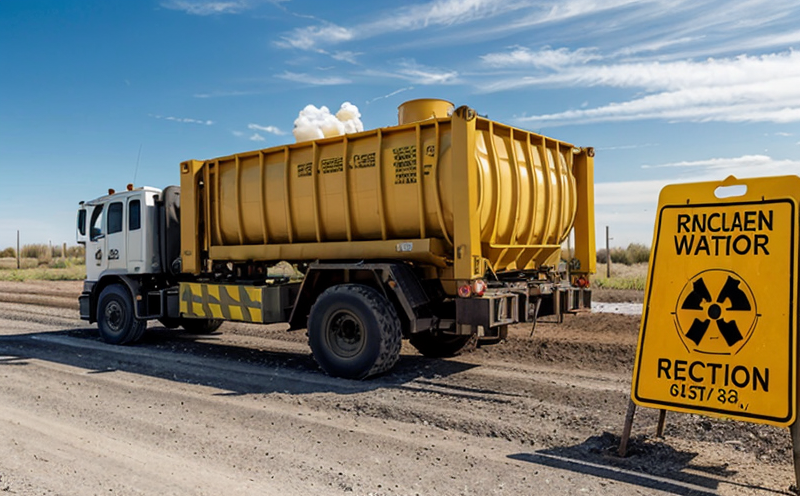ASTM D7286 Measurement of Beta Activity in Nuclear Waste
The measurement of beta activity in nuclear waste is critical for ensuring regulatory compliance and safety standards are met. This test, as per ASTM D7286, plays a pivotal role in the accurate quantification of beta-emitting radionuclides present within nuclear waste materials.
ASTM D7286 provides a standardized method for determining the specific activity of beta-emitting radionuclides using liquid scintillation counting. This technique is essential because it allows laboratories to precisely quantify the radioactivity levels, which directly impacts decisions regarding waste classification and disposal methods. Understanding these activities helps in minimizing environmental hazards associated with improper handling or disposal.
The process involves several key steps: first, the nuclear waste sample must be prepared for analysis by transferring it into a suitable vessel designed for liquid scintillation counting. The choice of vessel is crucial as it affects both the accuracy and reproducibility of results. Next, the sample undergoes thorough mixing to ensure uniform distribution of beta-emitting radionuclides throughout the solution. This step ensures reliable measurements.
After preparation, the sample is placed into a scintillation vial, which serves as the container for the liquid scintillant. The vial is then sealed and inserted into the scintillation counter. Inside this instrument, the beta particles emitted by radioactive isotopes interact with the scintillant, producing light that can be detected and measured.
Accurate measurement requires precise calibration of the scintillation counter using known standards. Calibration ensures that each unit response corresponds accurately to a defined level of radioactivity. Post-measurement analysis involves comparing the measured values against expected ranges based on waste composition data provided by regulatory bodies such as the International Atomic Energy Agency (IAEA).
This testing method is not only precise but also highly sensitive, capable of detecting even minute amounts of beta activity. Its importance cannot be overstated in ensuring public safety and environmental protection.
- Calibration: Ensures accurate measurement by aligning instrument responses with known standards.
- Data Accuracy: Provides reliable results that are essential for regulatory compliance.
- Sample Preparation: Critical steps include proper mixing and transfer into scintillation vials to ensure consistent readings.
- Instrumentation: The use of high-quality liquid scintillation counters guarantees accurate detection of beta particles.
The ASTM D7286 method is widely recognized for its reliability in measuring beta activity, making it an industry standard. Its application ensures that waste management practices are aligned with international standards and local regulations, thereby safeguarding both human health and the environment.
Eurolab Advantages
At Eurolab, we pride ourselves on delivering top-tier nuclear waste testing services. Our state-of-the-art facilities equipped with advanced instrumentation guarantee accurate and precise measurements of beta activity in nuclear waste samples.
- High Precision: Utilizing the latest technology ensures that our results are reliable and consistent.
- Experienced Staff: Our team comprises highly trained professionals specializing in radioactive materials analysis.
- Comprehensive Reporting: We provide detailed reports tailored to meet your specific needs, ensuring full transparency and traceability of data.
- Regulatory Compliance: All our processes adhere strictly to international standards like ASTM D7286, ensuring that you are always compliant with applicable regulations.
We understand the importance of accuracy in nuclear waste management. That's why we invest heavily in maintaining cutting-edge technology and continuously updating our methodologies based on latest industry developments. This commitment translates into superior service for our clients.
Why Choose This Test
- Regulatory Compliance: Ensures that your waste management practices align with stringent international standards.
- Safety: Precise measurement of beta activity helps in minimizing potential risks associated with improper handling or disposal of nuclear waste.
- Environmental Protection: By providing accurate data on radioactive content, this test supports effective mitigation strategies to protect the environment.
- Efficiency: Reliable results enable better decision-making regarding waste classification and disposal methods, streamlining operational processes.
- Confidence: With consistent and accurate measurements, you can have peace of mind knowing that your facilities meet all required standards.
- Expertise: Leveraging our team's extensive experience in radioactive materials analysis guarantees high-quality service.
Selecting ASTM D7286 for beta activity measurement offers numerous benefits beyond mere compliance. It enhances operational efficiency, promotes safety measures, and contributes significantly towards environmental conservation efforts.
International Acceptance and Recognition
The ASTM D7286 method enjoys broad international recognition and acceptance due to its robustness and reliability in measuring beta activity levels accurately. Regulatory bodies worldwide endorse this standard as it provides consistent and reliable data, which is crucial for effective nuclear waste management.
Many countries have adopted ASTM D7286 into their national standards or guidelines because of its comprehensive approach towards quantifying beta-emitting radionuclides in various nuclear waste streams. For instance, the European Union recommends using this method as part of its radioactive materials control framework. Similarly, organizations like the International Atomic Energy Agency (IAEA) and the US Nuclear Regulatory Commission (NRC) frequently reference ASTM D7286 when providing guidance on best practices for nuclear safety and environmental protection.
By adhering to ASTM D7286, laboratories can demonstrate their commitment to maintaining high standards of quality assurance and control. This consistency builds trust among stakeholders, including regulatory authorities, customers, and the public.





